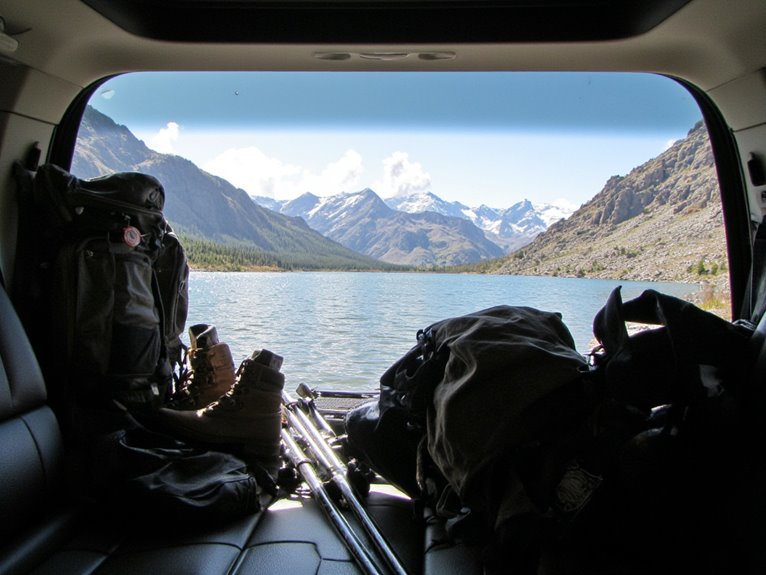Altitude Sickness Treatment: Descent Protocols and Medication
You must descend immediately 500-3,300 feet when altitude sickness symptoms appear, as this remains the most critical treatment intervention. Supplement with oxygen at 1-4 L/min to maintain saturation above 90%, while administering acetazolamide 250 mg every eight hours for symptom relief. For severe cases involving HACE or HAPE, use dexamethasone 4-8 mg doses or nifedipine 20 mg extended-release every six hours respectively. Understanding these protocols and their precise implementation can save lives in high-altitude emergencies.
We are supported by our audience. When you purchase through links on our site, we may earn an affiliate commission, at no extra cost for you. Learn more. Last update on 7th January 2026 / Images from Amazon Product Advertising API.
Notable Insights
- Immediate descent of 500 meters to 3,300 feet is critical for complete altitude sickness symptom resolution.
- Acetazolamide 250 mg every 8 hours treats established symptoms; 125 mg every 12 hours prevents altitude sickness.
- Dexamethasone 4-8 mg dosing treats moderate-to-severe AMS and HACE when descent is delayed or impossible.
- Supplemental oxygen at 1-4 L/min maintains saturation above 90% and alleviates headaches within 30 minutes.
- Nifedipine 20 mg extended-release every 6 hours effectively treats High Altitude Pulmonary Edema symptoms.
Emergency Descent Requirements and Distance Guidelines
When altitude sickness symptoms develop, immediate descent remains the most effective and reliable treatment option available.
You must descend 500 meters to 3,300 feet until symptoms completely resolve. Emergency protocols require immediate action for severe cases like HAPE and HACE to prevent life-threatening complications.
Descent urgency increases dramatically with symptom severity. You’ll need rapid evacuation methods when available-helicopters or motor vehicles work best. Remove heavy loads to minimize physical exertion during descent. Aim for the lowest possible altitude, especially with HAPE cases where mortality risk remains significant.
Monitor your condition continuously throughout descent. Use vehicles or pack animals when possible to reduce energy expenditure.
Don’t delay descent for any reason, as rapid symptom resolution depends entirely on reaching lower elevations quickly and safely.
Supplemental Oxygen Administration and Monitoring
While descent provides the most definitive treatment for altitude sickness, supplemental oxygen offers critical support when immediate evacuation isn’t possible or when managing severe symptoms during descent preparation.
Supplemental oxygen provides vital support for altitude sickness when immediate descent isn’t feasible or during evacuation preparation.
You’ll need to maintain oxygen saturation above 90% using appropriate oxygen delivery systems rather than focusing on fixed FiO2 percentages. Administer 1-4 L/min through nasal cannulas or masks for mild to moderate AMS, ensuring sustained delivery for at least two hours rather than brief high-flow bursts.
Monitor continuously with pulse oximetry to adjust flow rates based on patient response. Oxygen therapy provides effective symptom management, typically relieving headaches within 30 minutes to several hours.
You can combine oxygen with acetazolamide or dexamethasone for enhanced treatment, but remember that supplemental oxygen doesn’t replace descent requirements in severe cases.
Acetazolamide Dosing for Prevention and Treatment
You’ll need to adjust acetazolamide dosing based on whether you’re preventing altitude sickness or treating active symptoms.
Prevention requires 125 mg every 12 hours starting the day before ascent, while treatment demands higher doses of 250 mg every eight hours for faster symptom relief.
Pediatric patients require weight-based calculations at 2.5 to 5 mg/kg/day divided into two doses, with a maximum of 125 mg twice daily regardless of body weight.
Prevention Dosing Guidelines
Two primary dosing protocols exist for acetazolamide prevention of acute mountain sickness, with the standard adult dose being 125 mg every 12 hours and pediatric dosing at 2.5 mg/kg every 12 hours, not exceeding 125 mg per dose.
These acclimatization strategies require precise timing and dosage formulations for ideal effectiveness:
- Start medication the day before your ascent begins
- Continue treatment for two to four days at altitude
- Extend duration if you’re ascending to higher elevations
- Use immediate-release formulations for prevention protocols
You’ll find this lower dosing approach minimizes common side effects like paresthesia while maintaining clinical efficacy.
Studies demonstrate effectiveness at 250 mg daily, though some guidelines suggest higher doses up to 1000 mg in divided portions. The medication accelerates acclimatization and reduces symptom severity through enhanced ventilatory response.
Treatment Dose Increases
When treating established acute mountain sickness rather than preventing it, acetazolamide requires higher dosing protocols that differ considerably from preventive regimens.
The only treatment dose with clinical study backing is 250 mg taken twice, spaced eight hours apart. This represents a significant increase from the standard 125 mg every twelve hours used for prevention.
Treatment effectiveness depends on proper dose optimization, though higher doses haven’t been extensively researched beyond this protocol. You’ll often see acetazolamide combined with dexamethasone for severe AMS or HACE cases.
Treatment continues until symptoms resolve, typically requiring descent to lower altitude.
Monitor for increased paresthesia with higher doses. Remember that medication serves as supplementary treatment-descent remains the definitive intervention for severe altitude sickness.
Pediatric Weight Adjustments
Most pediatric acetazolamide dosing follows a weight-based calculation of 2.5 mg/kg every 12 hours, with each individual dose capped at 125 mg regardless of the child’s weight.
This approach guarantees you’re providing effective pediatric dosage calculations while minimizing adverse effects. The dosing scheme accommodates children of varying sizes without exceeding safety thresholds.
Essential weight-based considerations include:
- Calculate exact weight before prescribing, especially for infants and smaller children
- Begin treatment one day before ascent for best altitude acclimatization effects
- Continue dosing for 48-72 hours at altitude or until descent begins
- Monitor for side effects like paresthesia or altered taste during treatment
You’ll achieve therapeutic benefits within 24 hours compared to natural acclimatization taking 3-5 days.
Higher doses don’t improve efficacy but increase side effect risk.
Dexamethasone Use in Severe Altitude Illness
Dexamethasone serves as a critical intervention for moderate-to-severe acute mountain sickness (AMS) and high-altitude cerebral edema (HACE) when descent isn’t immediately feasible.
You’ll need 4 mg every six hours for AMS treatment, while HACE requires an 8 mg loading dose followed by 4 mg maintenance doses. Dexamethasone efficacy surpasses acetazolamide for severe conditions, rapidly stabilizing the blood-brain barrier and reducing inflammation.
Dexamethasone outperforms acetazolamide for severe altitude illness, requiring precise dosing protocols for AMS versus HACE treatment.
However, administration challenges complicate field use. Oral routes become problematic due to nausea and vomiting.
Intravenous delivery requires medical training that’s impractical for most climbers. Intramuscular injection offers the most feasible option for non-medical personnel with basic training.
Don’t discontinue treatment at altitude before acclimatization-rebound symptoms can occur. Treatment typically lasts one to two days.
HAPE-Specific Medications and Dosing Protocols
When descent or supplemental oxygen isn’t immediately available, you’ll need specific medications to reduce HAPE‘s dangerously elevated pulmonary artery pressure.
Nifedipine stands as the primary pharmacologic option, with immediate-release dosing at 10 mg orally followed by 20 mg extended-release every 6 hours, or alternatively 30 mg extended-release every 12 hours.
Phosphodiesterase-5 inhibitors like sildenafil (50 mg every 8 hours) and tadalafil (10 mg every 12 hours) serve as viable alternatives when nifedipine isn’t available, though their efficacy data remains limited compared to calcium channel blockers.
Nifedipine Dosing Protocols
Nifedipine serves as the primary pharmacological intervention for high-altitude pulmonary edema prevention and treatment, with established dosing protocols that differ markedly from its cardiovascular applications.
You’ll need sustained-release formulations specifically for HAPE management. The standard prevention and treatment dose remains 30 mg every 12 hours or 20 mg every 8 hours. Start dosing the day before your ascent to maximize nifedipine effectiveness.
Key dosing considerations include:
- Begin treatment 24 hours before ascent or immediately when symptoms appear
- Continue for 4-7 days after reaching target altitude
- Monitor blood pressure closely due to potential nifedipine side effects
- Avoid combination with other vasodilators to prevent dangerous hypotension
Duration matters critically. You must maintain consistent dosing throughout your high-altitude exposure period for optimal pulmonary vascular pressure reduction.
Phosphodiesterase Inhibitor Options
Although nifedipine remains the gold standard for HAPE pharmacotherapy, phosphodiesterase-5 (PDE5) inhibitors offer valuable alternative options when calcium channel blockers aren’t available or suitable for your specific situation.
PDE5 Mechanisms work by increasing cyclic guanosine monophosphate levels, causing selective pulmonary arterial smooth muscle relaxation without significant systemic hypotension. This targeted vasodilation reduces pulmonary artery pressures and improves oxygen saturation at altitude.
| Medication | Dosing Protocol | Duration | Primary Use | Key Advantage |
|---|---|---|---|---|
| Sildenafil | 20mg every 6-8 hours | Short-acting | Prevention/Treatment | Rapid onset |
| Tadalafil | 10mg every 12 hours | Long-acting | Prophylaxis | Extended coverage |
| Both | Oral administration | Variable | HAPE management | Nitrate-independent |
Clinical Efficacy data supports both prevention and treatment applications. These medications serve as adjuncts to descent and oxygen therapy, stabilizing symptoms during evacuation while reducing capillary leakage.
Pediatric Considerations and Weight-Based Dosing
Treating altitude sickness in children requires careful attention to weight-based dosing protocols that differ significantly from adult recommendations.
Children need precise weight-based medication dosing for altitude sickness treatment, not standard adult doses.
You’ll need to calculate medications precisely based on your child’s body weight rather than using standard adult doses.
Key pediatric dosing guidelines include:
- Acetazolamide: 1.25 mg/kg every 12 hours (max 125 mg) for prevention; 2.5 mg/kg every 12 hours (max 250 mg) for treatment
- Dexamethasone: 0.15 mg/kg every 6 hours (max 4 mg) for AMS and HACE treatment
- Pediatric hydration: Monitor fluid intake closely as dehydration worsens symptoms
- Altitude acclimatization: Use staged ascent with gradual sleeping elevation increases
Descent remains your primary treatment strategy.
Move down 1,000-3,300 feet immediately when symptoms appear. Supplemental oxygen helps while arranging evacuation to lower elevations.
Portable Hyperbaric Chambers and Temporary Stabilization
When descent isn’t immediately possible, portable hyperbaric chambers serve as critical emergency tools that can simulate a drop of 1,500 to 2,000 meters in altitude. You’ll use these devices specifically for severe AMS cases, including HAPE and HACE, not mild symptoms or prevention.
| Chamber Specifications | Operating Requirements | Clinical Limitations |
|---|---|---|
| Weight: 6.5-12.7 lbs | 12 strokes/minute pumping | Temporary stabilization only |
| Pressure: +104 mmHg | Continuous operator effort | No definitive treatment |
| Material: Reinforced nylon | CO2 buildup prevention | Descent still required |
The hyperbaric chamber design features durable nylon construction with clear viewing windows. You’ll need continuous foot pumping to maintain therapeutic pressure around 2 psig. Portable chamber maintenance requires leak testing and carrying repair materials like duct tape for emergency fixes.
Supportive Care Measures and Symptom Monitoring
Beyond emergency interventions like hyperbaric chambers, effective altitude sickness management relies heavily on systematic symptom monitoring and thorough supportive care measures.
You’ll need to assess headache, nausea, dizziness, and fatigue regularly as primary indicators. Mental status changes like confusion or coordination problems signal severe illness requiring immediate attention.
Your supportive care protocol should include:
- Rest with limited physical activity and controlled breathing techniques
- Adequate hydration while avoiding alcohol and smoking completely
- Over-the-counter pain relief using ibuprofen or paracetamol for headaches
- Antiemetic medications to manage nausea and improve fluid tolerance
Implement the buddy system for accurate symptom recognition, as individuals often underestimate their condition.
Monitor for cyanosis, particularly blue discoloration of lips, nails, and skin. Track symptom progression continuously during the critical 12-72 hour window following altitude gain.
Frequently Asked Questions
Can I Fly Commercially After Experiencing Altitude Sickness Symptoms?
You can fly commercially after experiencing altitude sickness symptoms, but proper symptom management is essential first.
Wait until all symptoms completely resolve before booking your flight. Consult your doctor if symptoms were severe or persistent.
Take travel precautions including staying well-hydrated and avoiding alcohol before departure.
You’re at higher risk for recurrence, so monitor your condition closely during future flights.
How Long Should I Wait Before Attempting to Re-Ascend After Recovery?
Your re-ascend timeline requires complete symptom resolution plus a minimum 5-day stabilization period at recovery altitude.
No universal timeline exists-severity of prior illness and individual tolerance determine timing.
Never attempt re-ascent within 24 hours of symptom resolution.
Gradual altitude acclimatization involves limiting gains to 300–600 meters daily with rest days every 600–1,200 meters.
Those with severe high-altitude illness history need longer stabilization periods and possible medical clearance.
Are There Any Dietary Restrictions While Taking Altitude Sickness Medications?
You’ll face minimal dietary considerations while taking altitude sickness medications. No specific food restrictions apply to acetazolamide or dexamethasone.
However, avoid activated charcoal and limit caffeine, as these create medication interactions that reduce effectiveness. Skip fatty foods since they slow absorption rates.
Maintain your high-carbohydrate diet and stay hydrated. Monitor appetite changes, especially with dexamethasone, which increases hunger considerably.
Can Pregnant Women Safely Use Acetazolamide or Dexamethasone for Altitude Sickness?
You shouldn’t use acetazolamide during pregnancy due to acetazolamide effects including potential teratogenic risks and FDA category C classification.
Dexamethasone safety data shows it’s only considered for life-threatening altitude emergencies when benefits outweigh fetal risks.
Both medications require strict medical supervision if absolutely necessary.
Immediate descent remains your safest treatment option, along with oxygen therapy and supportive care to avoid medication exposure.
What Should I Do if Symptoms Return After Initial Improvement?
If your symptoms return after initial improvement, halt further ascent immediately and remain at your current altitude until symptoms fully resolve.
Focus on symptom management using acetaminophen, NSAIDs, and increased fluid intake. Rest allows gradual acclimatization and reduces progression risk.
Monitor for worsening headache, nausea, or dizziness. Descend over 500 meters if symptoms worsen despite treatment, and don’t reascend until asymptomatic for 24-48 hours.
On a final note
You’ve got the tools to handle altitude sickness effectively. Descent remains your primary treatment-drop 1,500-3,000 feet immediately for severe symptoms. Don’t hesitate to use supplemental oxygen at 2-4 L/min or portable hyperbaric chambers for stabilization. Start acetazolamide at 250mg twice daily for prevention, dexamethasone 8mg initially for severe cases. Monitor symptoms closely and evacuate when necessary. Quick, decisive action saves lives at altitude.



